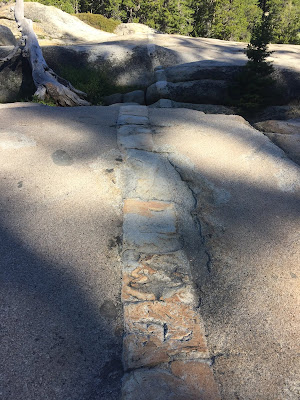“Charms to sooth a savage breast...” 1
On the 2018 summer solstice, I hiked the Sierras. This, to acclimate after a journey of 25,810 miles (41,536 km), from the southern to northern hemispheres, from winter to summer, from Zuma and Malema to Trump, and from KZN’s Midlands to CA’s unique combination of water, granite rocks, tall conifers, and open sky.
The day before the solstice, I departed my urban island-city home and, three hours later, pitched a small tent about 40 miles south of Lake Tahoe. This region—Carson Pass, Silver Lake, Eldorado National Forest –has charms to sooth this jet-lagged traveler’s breast. (Note: breast, not beast. 1)
We pitched out tent, secured all food and anything else with an enticing aroma into the campsite’s steel bear-proof locker.
Then we went to explore potholes.
Granite. It sounds so sturdy and impenetrable. Yet even granite succumbs to time and weathering. Snow, water, weather, and the unremitting persistence of lichen weaken, crack, and erode granite. Lichen—“liken” or “lit-chen”— is a tenacious lifeform. To the layperson, it's a “simple slow-growing plant that typically forms a low crustlike, leaflike, or branching growth on rocks, walls, and trees.” To the scientifically minded, it’s a “a composite organism made up of a fungus, usually an ascomycete, that grows symbiotically with an alga or a cyanobacterium and characteristically forms a crustlike or branching growth on rocks or tree trunks.” To the ceramic artist, it’s inspiration. I try to reproduce a lichen-like effect on my clay garden sculptures. Photographs help this effort and, here, I add to my lichen album.
Further inspiration: sedimentary dykes in granite.
At the 2018 mid-summer snow line….
On the banks of Lake Winnemucca, I pulled off my boots and socks and dipped a bare foot into the pristine water. Liquid snow! Immersing my bathing suit-clad body in that water—and surviving—seemed impossible. Instead, we sat on rocks among fallen trees, ate lunch, and greeted other hikers. For, yes, remarkably, at least eight hikers appeared–including a couple carrying an alert five-month-old in a Snuggly, followed by Buster the family dog. Turns out, there was an easier way to reach the lake from a closer trail head. Our hike route, however, was not difficult. I recommend it.
Want to hike here? Search Google for directions to “Silver Lake East Campground, Ca” (we stayed in the Kit Carson or Silver Lake West Campground):
The day before the solstice, I departed my urban island-city home and, three hours later, pitched a small tent about 40 miles south of Lake Tahoe. This region—Carson Pass, Silver Lake, Eldorado National Forest –has charms to sooth this jet-lagged traveler’s breast. (Note: breast, not beast. 1)
 |
| Looking from highway towards our destination where we planned to pitch a small tent, relax, and prepare to hike. |
 |
| Google Earth view 1: The spectacular body of water, San Francisco Bay, around my neighborhood. |
 |
| Google Earth view 2: Swapping the beach for granite, conifers, water…open sky... and bears. |
Potholes reprise
I was mistaken when I asserted in an earlier post that “Potholes” is not a sign seen in California. The context is different but potholes are alive and well –in our forests. |
Park rangers route hikers around a vegetation restoration project. |
 |
| Sign at Kit Carson campground. |
“To soften Rocks…”
Rocks of the Sierra Nevada are predominantly granite (metamorphic) formed during the Mesozoic Era (252 million to 66 million years ago (an era that included the planet’s greatest mass extinction—to date!—and an asteroid strike that killed off the dinosaurs).Granite. It sounds so sturdy and impenetrable. Yet even granite succumbs to time and weathering. Snow, water, weather, and the unremitting persistence of lichen weaken, crack, and erode granite. Lichen—“liken” or “lit-chen”— is a tenacious lifeform. To the layperson, it's a “simple slow-growing plant that typically forms a low crustlike, leaflike, or branching growth on rocks, walls, and trees.” To the scientifically minded, it’s a “a composite organism made up of a fungus, usually an ascomycete, that grows symbiotically with an alga or a cyanobacterium and characteristically forms a crustlike or branching growth on rocks or tree trunks.” To the ceramic artist, it’s inspiration. I try to reproduce a lichen-like effect on my clay garden sculptures. Photographs help this effort and, here, I add to my lichen album.
Further inspiration: sedimentary dykes in granite.
 |
| Open sky...or are those trees spewing clouds? |
A Round Top solstice
Next day, June 21st, lunch and bathing suits packed, boots fitted, we headed to the foot of Round Top. I’ve never been there before and the view of the mountain through the trees—imposing, steep, and oh-so-distant—made it hard to imagine reaching it. The possibility of swimming in Lake Winnemucca, however, spurred me on. |
| Destination: the foot of Round Top, (elev 10,400 feet).as seen in the distance through trees at about 8,000 feet. . |
 |
| Getting closer... |
At the 2018 mid-summer snow line….
 |
 |
| The foot of Round Top: Lake Winnemucca. |
Want to hike here? Search Google for directions to “Silver Lake East Campground, Ca” (we stayed in the Kit Carson or Silver Lake West Campground):
Highway 80 towards Sacramento.
At Sacramento, take highway US-50 East.
US-50 E to Sly Park Rd in Pollock Pines.
Exit 60 from US-50 towards Sly Park Rd.
Right onto Sly Park Rd.
After 4.6 miles, go left on Mormon Emigrant Trail/Silver Lake Rd.
Left on Highway 88, then about 7 miles to Silver Lake West Campground (on the left, past the base of the lake).
(All photos: © Susan Galleymore, June 21, 2018.)
(All photos: © Susan Galleymore, June 21, 2018.)
1 In 1697, William Congreve wrote:
Musick has Charms to sooth a savage Breast,
To soften Rocks, or bend a knotted Oak.
Read The Mourning Bride >>
Google indicates twice as many searchers seek “beast,” the incorrect version, than “breast.” ↩









